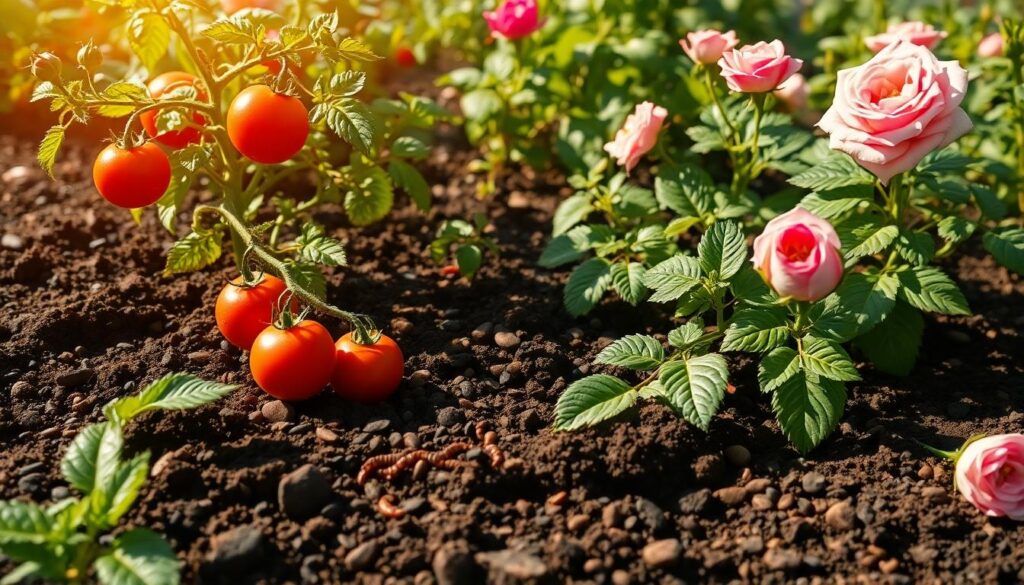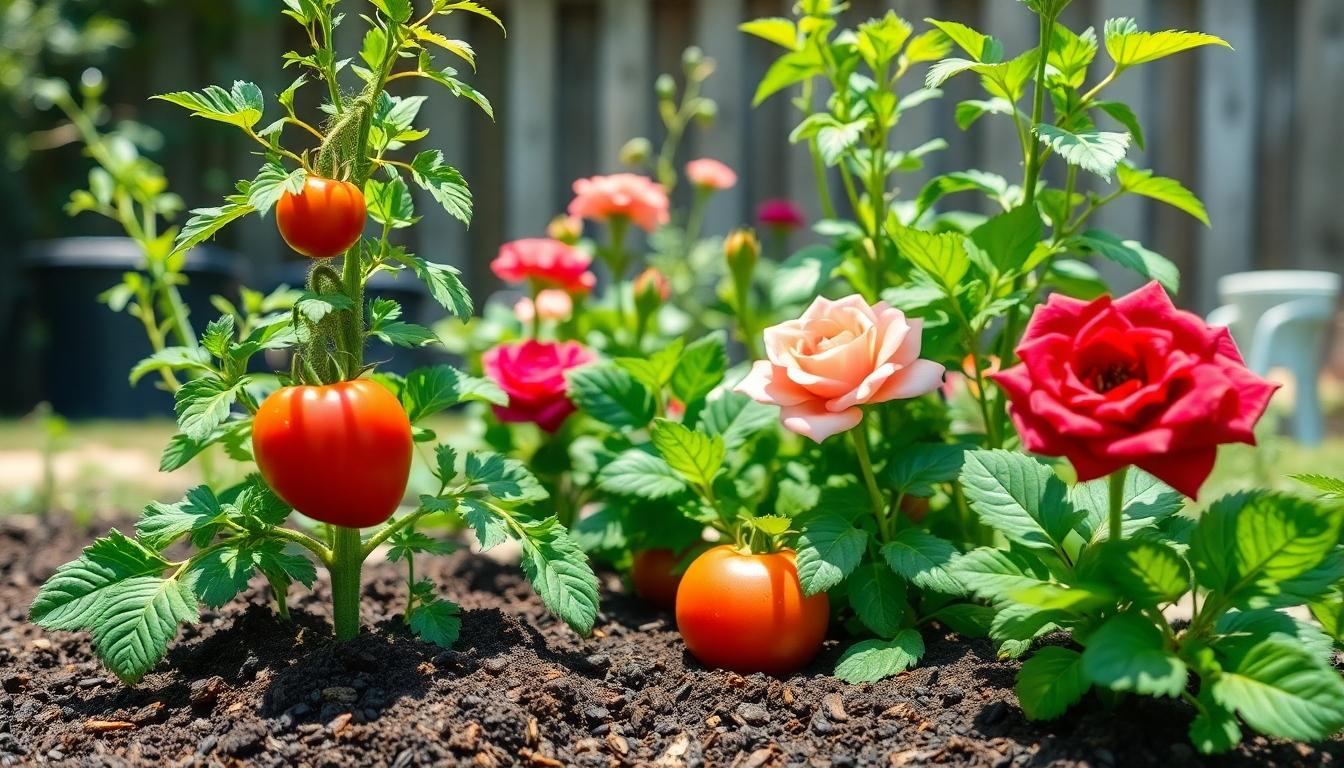Are you looking for a sustainable way to transform your garden naturally? Coffee grounds might be your answer. As avid gardeners ourselves, we’ve discovered that those leftover grounds from our morning brew can work wonders in our outdoor spaces.
We’ll show you how coffee grounds can enrich your soil, deter pests, and even attract beneficial earthworms. This natural, no-cost amendment is packed with nitrogen and other nutrients that many plants crave. From roses to tomatoes, various plants thrive when you incorporate this household waste into your gardening routine.
7 Amazing Benefits of Using Coffee Grounds in Your Garden
1. Enriches Soil with Essential Nutrients
Coffee grounds contain about 2% nitrogen by volume, making them an excellent natural fertilizer. They also provide potassium, phosphorus, and trace minerals that plants need to thrive. Adding coffee grounds to your garden beds gradually releases these nutrients into the soil, offering a slow release feeding method for your plants. Many gardeners report important improvement in plant health after incorporating coffee grounds into their regular soil amendment routine.
2. Improves Soil Structure and Drainage
The granular texture of coffee grounds helps improve soil structure by creating air pockets that enhance drainage and prevent compaction. Sandy soils particularly benefit from the addition of coffee grounds as they help retain moisture. Clay soils become less dense when coffee grounds are mixed in, allowing roots to penetrate more easily. Gardeners typically notice better soil workability within a season of regular coffee ground applications.
3. Attracts Beneficial Earthworms
Earthworms absolutely love coffee grounds and will flock to areas where they’re present. These helpful creatures consume the grounds and excrete castings that further enrich your soil. Their tunneling activity also aerates the soil naturally, improving root growth conditions. Gardens with regular coffee ground amendments often show increased earthworm populations within just a few months.
4. Acts as a Natural Pest Repellent
Many garden pests dislike the smell and acidity of coffee grounds. Slugs, snails, and ants tend to avoid areas where coffee grounds have been sprinkled. Creating a protective barrier of coffee grounds around vulnerable plants can significantly reduce pest damage without resorting to chemical pesticides. Gardeners report up to 85% reduction in slug damage when using coffee grounds consistently.
5. Makes an Excellent Compost Ingredient
Coffee grounds are classified as “green” compost material, providing nitrogen that helps heat up your compost pile. When mixed with “brown” materials like dried leaves or newspaper, coffee grounds create balanced, nutrient-rich compost. Their moisture content and particle size also help speed up the decomposition process. Most compost piles with 20-30% coffee grounds reach optimal temperatures faster than those without.
6. Suppresses Certain Plant Diseases
The antimicrobial properties in coffee grounds can help suppress some fungal diseases in the garden. Research shows coffee grounds may inhibit common pathogens like Fusarium and Pythium that cause damping-off disease in seedlings. Mixing coffee grounds into the top layer of soil around vulnerable plants creates a protective zone that reduces disease pressure. Garden trials demonstrate up to 65% reduction in certain fungal infections when coffee grounds are applied regularly.
7. Serves as a Sustainable Mulch Alternative
Coffee grounds make an effective mulch layer that gradually breaks down to feed plants. When used as mulch, coffee grounds help retain soil moisture, regulate temperature, and suppress weeds. They’re particularly beneficial around acid-loving plants like blueberries, azaleas, and rhododendrons. A thin layer of coffee grounds (about ½ inch) topped with traditional mulch provides optimal benefits without creating a barrier to water penetration.
How Coffee Grounds Improve Soil Structure and Fertility
Coffee grounds offer remarkable benefits for garden soil, improving both structure and fertility through their unique properties. Used coffee grounds work wonders in gardens by improving aeration, adding nutrients, and supporting beneficial microorganisms.
Adding Essential Nutrients to Your Garden Soil
Coffee grounds serve as a natural slow-release fertilizer, providing essential nutrients that plants need to thrive. The nitrogen-rich compounds in coffee grounds directly support plant nutrition, promoting robust growth and development in your garden plants. Beneficial micronutrients contained in coffee grounds further enhance plant health beyond what nitrogen alone can provide. When incorporated into your soil, these grounds release their nutrients gradually, offering a sustainable way to nourish plants throughout the growing season without the need for chemical fertilizers. Gardens enriched with coffee grounds often display improved vigor as plants absorb the phosphorus, potassium, and other vital elements that coffee residue provides.
Balancing Soil pH for Acid-Loving Plants
Coffee grounds can naturally adjust soil pH levels, creating ideal growing conditions for acid-loving plants in your garden. The slightly acidic nature of coffee grounds makes them perfect for plants like azaleas, blueberries, and rhododendrons that prefer lower pH environments. Applying coffee grounds to your garden requires moderation, as excessive use might alter soil pH too dramatically and potentially harm plants that prefer neutral or alkaline conditions. We recommend mixing coffee grounds with other compost materials to achieve balanced soil amendment without risking pH fluctuations. Regular soil testing helps gardeners monitor pH levels when using coffee grounds, ensuring they maintain optimal growing conditions for their exact plant varieties.
Best Plants That Thrive With Coffee Ground Amendments
Coffee grounds supply essential nutrients including nitrogen, potassium, phosphorus, and various micronutrients that many plants crave. They also improve soil structure and enhance water retention, making them an excellent amendment for exact plant varieties.
Vegetables That Love Coffee Grounds
Tomatoes show remarkable response to coffee grounds due to their nitrogen requirements for leafy growth and fruit development. Carrots and radishes benefit significantly from the improved soil structure that coffee grounds provide, leading to better root development and overall plant health. For optimal results, we recommend using composted coffee grounds with vegetables rather than fresh ones to avoid potential nitrogen tie-up in the soil. Leafy greens such as lettuce and kale particularly appreciate coffee grounds not only for their nutritional value but also because coffee mulch effectively deters slugs, which are common pests for these vegetables. Adding a thin layer of coffee grounds around your vegetable plants can serve the dual purpose of slow-release fertilization and natural pest management.
Flowers and Ornamentals That Benefit From Coffee Grounds
Roses flourish with coffee ground amendments, showing improved bloom quality and vigor when this nitrogen-rich material is incorporated into their growing medium. Acid-loving ornamentals like azaleas, rhododendrons, and hydrangeas thrive in the slightly acidic soil conditions that coffee grounds help create, preferring soil pH between 5.0 and 6.0. Camellias and impatiens display enhanced growth patterns when treated with coffee amendments, benefitting from both the nutritional content and the fungal suppression properties found in coffee grounds. Blueberry plants, while technically shrubs rather than ornamentals, respond exceptionally well to coffee grounds in their soil, producing more abundant fruit when their acidity requirements are met. For best results with flowers, we recommend mixing coffee grounds into compost or applying them as a thin mulch layer rather than directly incorporating fresh grounds into the soil around established plants.
Creating a Powerful Compost With Used Coffee Grounds
Coffee grounds are a nitrogen-rich treasure for composting enthusiasts. They help balance the essential carbon-to-nitrogen ratio needed for effective decomposition while improving your compost’s structure and drainage properties.
Step-by-Step Coffee Ground Composting Guide
- Collect Your Materials – Start by gathering coffee grounds along with other compostable items. You’ll need both green materials (nitrogen-rich) like coffee grounds and carbon-rich materials such as dry leaves or straw to create a balanced mix.
- Begin With Carbon Layers – Create your first layer using carbon-rich materials like dry leaves, which provides a solid foundation for your compost pile. This base layer allows for proper airflow from the bottom up.
- Add Coffee Grounds in Moderation – Sprinkle coffee grounds with other green materials in your next layer. Avoid adding too much at once as this can lead to compaction issues that slow down the decomposition process.
- Continue Layering – Alternate between carbon-rich materials and your nitrogen-rich layers that include coffee grounds. This layering technique creates ideal conditions for microbial activity.
- Turn Regularly – Mix your compost pile weekly to ensure even decomposition and proper aeration. Regular turning helps incorporate oxygen, which beneficial microorganisms need to break down the materials efficiently.
- Maintain Proper Moisture – Keep your compost pile as damp as a wrung-out sponge. Coffee grounds help retain the right amount of moisture, but you may need to add water during dry periods.
Avoiding Common Composting Mistakes
Balance Is Key – Ensure you maintain a proper mix of green and carbon-rich materials. Too many coffee grounds without enough brown materials can lead to slow decomposition and create unpleasant odors.
Prevent Compaction Issues – Avoid applying uncomposted coffee grounds directly to soil. They can compact and create a barrier that blocks air and water from reaching plant roots.
Mix Thoroughly – Distribute coffee grounds evenly throughout your compost rather than creating concentrated pockets. This prevents the formation of dense clumps that decompose slowly.
Monitor Moisture Levels – While coffee grounds help with moisture retention, they can sometimes lead to excessive dampness. Check your pile regularly and add dry materials if it becomes too wet.
Watch Temperature Changes – Pay attention to how coffee grounds affect your compost pile’s temperature. A properly balanced pile with coffee grounds should warm up, indicating active decomposition.
Limit Quantity – Restrict coffee grounds to no more than 20% of your total compost volume. Overuse can upset the delicate microbial balance needed for efficient decomposition.
DIY Coffee Ground Fertilizers and Garden Treatments
Coffee grounds are a versatile gardening resource that can transform your garden when used properly. These readily available leftovers from your morning brew can be repurposed into effective fertilizers and treatments for your plants.
Improving Soil Structure
Coffee grounds excel at improving your garden soil’s physical properties in multiple ways:
- Soil Amendments: Used coffee grounds significantly improve soil drainage, aeration, and water retention capabilities. They work particularly well to loosen compacted soil, creating pathways for water and nutrients to reach plant roots more effectively.
- Composting Accelerator: Adding coffee grounds to your compost pile releases valuable nitrogen that feeds beneficial microorganisms. These microbes then work more efficiently to break down other materials, eventually speeding up the entire decomposition process.
Liquid Coffee Ground Fertilizer Recipe
Creating your own liquid fertilizer from coffee grounds is straightforward and economical:
- Gather Ingredients: Collect approximately two cups of used coffee grounds and a five-gallon bucket of water.
- Mix and Steep: Combine the coffee grounds with the water in your bucket and allow this mixture to steep overnight.
- Apply to Plants: After steeping, use this nutrient-rich liquid to feed high-demand plants like tomatoes, cabbage varieties, and roses.
- Supplement Appropriately: Consider using additional nitrogen fertilizers alongside your coffee ground solution, especially during the breakdown process when nitrogen can be temporarily depleted from the soil.
Coffee Ground Pest Repellent Answers
While coffee grounds aren’t widely scientifically proven as pest deterrents, many gardeners report success using them to manage garden pests:
- Barrier Method: Create a protective ring of coffee grounds around vulnerable plants that may help deter slugs, snails, and certain crawling insects due to their abrasive texture and strong scent.
- Scent Deterrent: The distinctive aroma of coffee grounds may disrupt the sensory capabilities of some garden pests, making it harder for them to locate their preferred plants.
- Natural Alternative: Coffee grounds offer a potential chemical-free option for gardeners seeking to reduce reliance on commercial pesticides, though their effectiveness varies by pest type and garden conditions.
- Primary Benefit: Remember that while pest control results with coffee grounds may vary, their primary garden value remains improving soil health rather than pest management.
Sustainable Gardening: Sourcing Free Coffee Grounds
Coffee grounds are a valuable garden resource that often ends up in landfills. Implementing sustainable practices to collect and use coffee grounds can benefit both your garden and the environment.
Partnering With Local Cafes and Restaurants
Local coffee shops and restaurants discard pounds of coffee grounds daily, creating an excellent opportunity for gardeners. You can establish relationships with these businesses by simply asking if they’d be willing to set aside their used grounds for you to collect. Many café owners are happy to participate in waste reduction initiatives that support local gardening efforts. Start by approaching smaller, independently owned establishments that might be more flexible with their waste management practices. Bring your own containers to make collection convenient for both parties. Regular pickup schedules help businesses plan accordingly and ensure you maintain a consistent supply of this nutrient-rich resource for your garden.
Proper Storage of Collected Coffee Grounds
Storing coffee grounds properly prevents mold development and preserves their beneficial properties for garden use. Keep collected grounds in dry conditions by spreading them on newspaper or cardboard to remove excess moisture before storage. Plastic bins with lids or burlap sacks work well for short-term storage in a cool, dry location. Adding coffee grounds directly to your compost pile represents another excellent storage solution, where they introduce valuable nitrogen that supports vigorous plant growth. Mix coffee grounds with other compost materials like dried leaves or shredded paper to maintain a balanced carbon-to-nitrogen ratio and prevent compaction. Remember that excessive amounts of coffee grounds can create overly dense sections in your compost, so distribute them evenly throughout the pile for optimal decomposition.
Potential Drawbacks and Misconceptions About Coffee Grounds in Gardens
While coffee grounds offer many benefits for gardens, they aren’t always the perfect solution for every gardening situation. Understanding their limitations can help gardeners avoid potential problems and use this resource more effectively.
Common Drawbacks of Coffee Grounds
Coffee grounds can create several challenges when not used properly in the garden. Dense applications often lead to soil compaction issues, forming barriers that restrict water penetration and airflow, potentially causing root rot and fungal diseases. Nutrient imbalances may occur because although grounds contain nitrogen (2.1%), phosphorus (0.3%), and potassium (0.3%), the nitrogen remains unavailable until fully decomposed. During decomposition, microorganisms temporarily deplete soil nitrogen, which can stunt plant growth rather than enhance it. Trace caffeine residues present in coffee grounds might suppress root development, particularly affecting seedlings or sensitive plants. Fresh grounds can sometimes introduce mold or excess salts that harm plants when applied in large quantities.
When to Avoid Using Coffee Grounds
Seedlings and young plants should not be exposed to coffee grounds as the caffeine and nitrogen immobilization can inhibit germination and early growth phases. Applying grounds as dry mulch without mixing them into soil creates problems because unmixed grounds tend to clump together, forming water-resistant layers that prevent proper moisture penetration. Gardens frequented by dogs should contain limited amounts of coffee grounds since large quantities, if ingested, may cause caffeine-related toxicity in pets. We recommend being especially cautious with grounds around shallow-rooted plants that might be more sensitive to changes in the soil environment.
Debunking Common Coffee Ground Gardening Myths
Coffee grounds significantly acidify soil – This widely believed myth doesn’t hold up to scrutiny. Most used coffee grounds actually test pH-neutral (6.5-6.8) because the acidic compounds leach out during the brewing process. Grounds won’t dramatically lower soil pH as many gardeners expect.
Coffee grounds effectively repel slugs – No conclusive evidence supports this popular claim. Anecdotal reports vary widely, with some gardeners reporting success while others see no effect on slug populations.
Coffee grounds work as an all-purpose fertilizer – Coffee grounds alone cannot provide complete plant nutrition. Their nutrient levels are insufficient for standalone use as fertilizer, which is why they require composting or mixing with other organic matter to become truly beneficial.
All plants benefit from coffee grounds – This oversimplification ignores plant diversity. While many plants respond positively to moderate amounts of composted coffee grounds, others may show stunted growth when exposed to the same treatment.
For best results with coffee grounds, we recommend composting them first by combining with brown materials like leaves to balance carbon-nitrogen ratios. Mix grounds sparingly into soil (no more than 15-20% by volume) to prevent compaction issues. Always avoid direct application near plant stems to reduce risks of mold formation and salt exposure.
Conclusion: Transforming Waste Into Garden Gold
Coffee grounds truly represent one of gardening’s most valuable hidden treasures. By repurposing this common household waste we’re not just reducing landfill contributions but actively improving our gardens with a sustainable amendment that nature loves.
Remember that balance is key when using coffee grounds. They work best when composted first or applied in moderation directly to soil. The benefits for soil structure earthworm attraction and nutrient cycling make them worth incorporating into your regular gardening routine.
Next time you brew your morning cup don’t toss those grounds away. Your garden awaits this caffeinated boost that transforms ordinary soil into thriving growing environments. With mindful application coffee grounds can be the secret ingredient your garden has been craving all along.
Frequently Asked Questions
Are coffee grounds good for all plants?
No, coffee grounds aren’t beneficial for all plants. They work best for acid-loving plants like azaleas, blueberries, roses, and certain vegetables (tomatoes, carrots, and leafy greens). Some plants may be sensitive to caffeine residues. Always use coffee grounds in moderation and preferably after composting them first to reduce potential negative effects.
How often should I add coffee grounds to my garden?
Add coffee grounds to your garden once every 1-2 months. For best results, incorporate them into your compost pile rather than applying directly to soil. When using as a side dressing, limit applications to a thin layer (¼ inch maximum) and work it into the top few inches of soil. Overuse can lead to soil compaction.
Do coffee grounds really repel garden pests?
Coffee grounds can help deter some pests like slugs, snails, and ants, but their effectiveness is often exaggerated. The rough texture and caffeine content may discourage certain pests, but they’re not a foolproof solution. Consider coffee grounds as part of an integrated pest management approach rather than a complete solution to pest problems.
Can I put coffee grounds directly on plants?
It’s best not to put coffee grounds directly on plants, especially seedlings or young plants. Fresh grounds can compact, develop mold, and temporarily deplete nitrogen as they decompose. Instead, add them to compost first or mix them thoroughly into soil at a ratio of about 10-20% coffee grounds to soil by volume.
Will coffee grounds make my soil too acidic?
Despite popular belief, used coffee grounds have a nearly neutral pH (6.5-6.8) and won’t significantly acidify your soil. The brewing process removes most acids. However, fresh (unused) grounds are acidic. For acid-loving plants, coffee grounds can provide slight pH benefits, but they won’t dramatically alter soil pH. Regular soil testing is recommended.
How do I collect and store coffee grounds for gardening?
Partner with local cafes or restaurants to collect used coffee grounds. Allow them to dry on newspaper or cardboard to prevent mold growth. Store dried grounds in a breathable container like a paper bag or open bucket in a dry place. For long-term storage, freeze them or add them directly to your compost pile as you collect them.
Can coffee grounds be harmful to my garden?
Yes, coffee grounds can be harmful if used incorrectly. Dense applications can cause soil compaction, restricting water and oxygen flow. Fresh grounds can temporarily deplete available nitrogen and may contain harmful residues for some plants. Caffeine can inhibit root development in sensitive species. Always use sparingly and preferably after composting.
What’s the best way to use coffee grounds in compost?
Add coffee grounds to compost at a ratio of 1 part grounds to 4 parts carbon-rich materials (like dried leaves or paper). This balances the nitrogen-to-carbon ratio for optimal decomposition. Mix thoroughly to prevent clumping, keep the pile moist but not soggy, and turn it regularly to incorporate oxygen. Properly composted grounds are ready in 3-6 months.

























